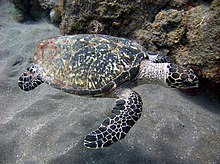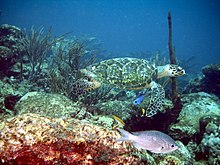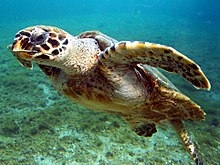The hawksbill's appearance is similar to that of other marine turtles. It has a generally flattened body shape, a protective carapace, and flipper-like arms, adapted for swimming in the open ocean. E. imbricata is easily distinguished from other sea turtles by its sharp, curving beak with prominent tomium, and the saw-like appearance of its shell margins. Hawksbill shells slightly change colors, depending on water temperature. While this turtle lives part of its life in the open ocean, it spends more time in shallow lagoons and coral reefs.
Human fishing practices threaten E. imbricata populations with extinction. The World Conservation Union classifies the hawksbill as critically endangered.[1] Hawksbill shells were the primary source of tortoiseshell material used for decorative purposes. The Convention on International Trade in Endangered Species outlaws the capture and trade of hawksbill sea turtles and products derived from them.[3]

Anatomy and morphology
E. imbricata has the typical appearance of a marine turtle. Like the other members of its family, it has a depressed body form and flipper-like limbs adapted for swimming.
Several characteristics of the hawksbill sea turtle distinguish it from other sea turtle species. Its elongated, tapered head ends in a beak-like mouth (from which its common name is derived), and its beak is more sharply pronounced and hooked than others. The hawksbill's arms have two visible claws on each flipper.
One of the hawksbill's more easily distinguished characteristics is the pattern of thick scutes that make up its carapace. While its carapace has five central scutes and four pairs of lateral scutes like several members of its family, E. imbricata's posterior scutes overlap in such a way as to give the rear margin of its carapace a serrated look, similar to the edge of a saw or a steak knife. The turtle's carapace has been known to reach almost 1 m (3 ft) in length.[6]
Hawksbill sea turtles' sand tracks are asymmetrical, because they crawl on land with an alternating gait. By contrast, the green sea turtle and the leatherback turtle crawl rather symmetrically.[7][8]
Due to its consumption of venomous cnidarians, hawksbill sea turtle flesh can become toxic.[9]
Distribution
Hawksbill sea turtles have a wide range, found predominantly in tropical reefs of the Indian, Pacific, and Atlantic Oceans. Of all the sea turtle species, E. imbricata is the one most associated with warm tropical waters. Two major subpopulations are acknowledged to exist, the Atlantic and Indo-Pacific subpopulations.[10]Atlantic subpopulation
In the Atlantic, hawksbill populations range as far west as the Gulf of Mexico and as far southeast as the Cape of Good Hope in South Africa.[10][11][12] They live off the Brazilian coast (specifically Bahia) through southern Florida and the waters off Virginia.[4] The species' range extends as far north as the Long Island Sound and Massachusetts[13] in the west Atlantic and the frigid waters of the English Channel in the east (the species' northernmost sighting to date).In the Caribbean, the main nesting beaches are in the Lesser Antilles, Barbados,[14] Guadeloupe,[15] Tortuguero in Costa Rica,[16] and in the Yucatan. They feed in the waters off Cuba[17] and around Mona Island near Puerto Rico[18] among other places.
Indo-Pacific subpopulation
In the Indian Ocean, hawksbills are a common sight along the east coast of Africa, including the seas surrounding Madagascar and nearby island groups, and all along the southern Asian coast, including the Persian Gulf, the Red Sea, and the coasts of the Indian Subcontinent and Southeast Asia. They are present across the Malay Archipelago and northern Australia. Their Pacific range is limited to the ocean's tropical and subtropical regions. In the west, it extends from the southwestern tips of the Korean Peninsula and the Japanese Archipelago down to northern New Zealand.The Philippines hosts several nesting sites, including the island of Boracay.[19] A small group of islands in the southwest of the archipelago has been named the "Turtle Islands" because two species of sea turtles nest there: the hawksbill and the green sea turtle.[20] In Hawaii, hawksbills mostly nest on the "main" islands of Oahu, Maui, Molokai, and Hawaii.[21] In Australia, hawksbills are known to nest on Milman Island in the Great Barrier Reef.[22] Hawksbill sea turtles nest as far west as Cousine Island in the Seychelles, where the species has been legally protected since 1994, and the population is showing some recovery.[23] The Seychelles' inner islands and islets, such as Aldabra, are popular feeding grounds for immature hawksbills.[8][24]
Eastern Pacific subpopulation
In the eastern Pacific, hawksbills are known to occur from the Baja Peninsula in Mexico south along the coast to southern Peru.[10] Nonetheless, as recently as 2007, the species had been considered largely extirpated in the region.[25] Important remnant nesting and foraging sites have since been discovered in Mexico, El Salvador, Nicaragua, and Ecuador, providing new opportunities for research and conservation. In contrast to their traditional roles in other parts of the world, where hawksbills primarily inhabit coral reefs and rocky substrate areas, in the eastern Pacific, hawksbills tend to forage and nest principally in mangrove estuaries, such as those present in the Bahia de Jiquilisco (El Salvador), Gulf of Fonseca (Nicaragua, El Salvador, and Honduras), Estero Padre Ramos (Nicaragua), and the Gulf of Guayaquil (Ecuador).[26] Multi-national initiatives, such as the Eastern Pacific Hawksbill Initiative, are currently pushing efforts to research and conserve the population, which remains poorly understood.Ecology
Habitat
Adult hawksbill sea turtles are primarily found in tropical coral reefs. They are usually seen resting in caves and ledges in and around these reefs throughout the day. As a highly migratory species, they inhabit a wide range of habitats, from the open ocean to lagoons and even mangrove swamps in estuaries.[6][27] Little is known about the habitat preferences of early life-stage E. imbricata; like other sea turtle young, they are assumed to be completely pelagic, remaining at sea until they mature.[28]Feeding

Hawksbills are highly resilient and resistant to their prey. Some of the sponges they eat, such as Aaptos aaptos, Chondrilla nucula, Tethya actinia, Spheciospongia vesparium, and Suberites domuncula, are highly (often lethally) toxic to other organisms. In addition, hawksbills choose sponge species with significant numbers of siliceous spicules, such as Ancorina, Geodia (G. gibberosa[4]), Ecionemia, and Placospongia.[29]
Life history

Breeding
Hawksbills mate biannually in secluded lagoons off their nesting beaches in remote islands throughout their range. Mating season for Atlantic hawksbills usually spans April to November. Indian Ocean populations, such as the Seychelles hawksbill population, mate from September to February.[8] After mating, females drag their heavy bodies high onto the beach during the night. They clear an area of debris and dig a nesting hole using their rear flippers, then lay clutches of eggs and cover them with sand. Caribbean and Florida nests of E. imbricata normally contain around 140 eggs. After the hours-long process, the female then returns to the sea.[6][11]The baby turtles, usually weighing less than 24 g (0.85 oz) hatch at night after around two months. These newly emergent hatchlings are dark-colored, with heart-shaped carapaces measuring around 2.5 cm (0.98 in) long. They instinctively crawl into the sea, attracted by the reflection of the moon on the water (possibly disrupted by light sources such as street lamps and lights). While they emerge under the cover of darkness, baby turtles that do not reach the water by daybreak are preyed upon by shorebirds, shore crabs, and other predators.[6]

Early life
The early life history of juvenile hawksbill sea turtles is unknown. Upon reaching the sea, the hatchlings are assumed to enter a pelagic life stage (like other marine turtles) for an undetermined amount of time. While hawksbill sea turtle growth rates are not known, when juveniles reach around 35 cm (14 in), they switch from a pelagic lifestyle to living on coral reefs.Maturity
Hawksbills evidently reach maturity after 30 years.[11] They are believed to live from 30 to 50 years in the wild.[37] Like other sea turtles, hawksbills are solitary for most of their lives; they meet only to mate. They are highly migratory.[30] Because of their tough carapaces, adults' only predators are sharks, estuarine crocodiles, octopuses, and some species of pelagic fish.[30]A series of biotic and abiotic cues, such as individual genetics, foraging quantity and quality [38] or population density, may trigger the maturation of the reproductive organs and the production of gametes and thus determine sexual maturity. Like many reptiles, all marine turtles of a same aggregation are highly unlikely to reach sexual maturity at the same size and thus age.[39] Age at maturity has been estimated to occur between 10[40] and 25 years of age[41] for Caribbean hawksbills. Turtles nesting in the Indo-Pacific region may reach maturity at a minimum of 30 to 35 years.[42][43]
Evolutionary history
Within the sea turtles, E. imbricata has several unique anatomical and ecological traits. It is the only primarily spongivorous reptile. Because of this, its evolutionary position is somewhat unclear. Molecular analyses support placement of Eretmochelys within the taxonomic tribe Carettini, which includes the carnivorous loggerhead and ridley sea turtles, rather than in the tribe Chelonini, which includes the herbivorous green turtle. The hawksbill probably evolved from carnivorous ancestors.[44]Etymology and taxonomic history

Two subspecies are accepted in E. imbricata's taxon. E. i. bissa (Rüppell, 1835) refers to populations that reside in the Pacific Ocean.[48] The Atlantic population is a separate subspecies, E. i. imbricata (Linnaeus, 1766). The nominate subspecies is the Atlantic taxon, because Linnaeus' type specimen was from the Atlantic.[49]
Fitzinger derived the genus' name, Eretmochelys, from the Greek roots eretmo and chelys, corresponding to "oar" and "turtle", respectively. The name refers to the turtles' oar-like front flippers. The species' name imbricata is Latin, corresponding to the English term imbricate. This appropriately describes the turtles' overlapping posterior scutes. The Pacific hawksbill's subspecies name, bissa, is Latin for "double". The subspecies was originally described as Caretta bissa; the term referred to the then-species being the second species in the genus.[50] Caretta is the genus of the hawksbill's much larger relative, the loggerhead turtle.
Exploitation by humans
Throughout the world, hawksbill sea turtles are taken by humans, though it is illegal to hunt them in many countries.[51] In some parts of the world, hawksbill sea turtles are eaten as a delicacy. As far back as the fifth century BC, sea turtles, including the hawksbill, were eaten as delicacies in China.[52]Many cultures also use turtles' shells for decoration. These turtles have been harvested for their beautiful shell since Egyptian times, and the material known as tortoiseshell is normally from the hawksbill.[53] In China, where it was known as tai mei, the hawksbill is called the "tortoise-shell turtle", named primarily for its shell, which was used for making and decorating a variety of small items, as it was in the West.[52] In Japan, the turtles are also harvested for their shell scutes, which are called bekko in Japanese. It is used in various personal implements, such as eyeglass frames and the shamisen (Japanese traditional three-stringed instrument) picks.[53] In 1994, Japan stopped importing hawksbill shells from other nations. Prior to this, the Japanese hawksbill shell trade was around 30,000 kg (66,000 lb) of raw shells per year.[17][54] In the West, hawksbill sea turtle shells were harvested by the ancient Greeks and ancient Romans for jewelry, such as combs, brushes, and rings.[55] The bulk of the world's hawksbill shell trade originates in the Caribbean. In 2006, processed shells were regularly available, often in large amounts, in countries including the Dominican Republic and Colombia.[56]
The hawksbill sea turtle appears on the reverse side of the Venezuelan 20-bolivar and the Brazilian 2-reais banknotes. A much-beloved fountain sculpture of a boy riding a hawksbill, affectionately known as Turtle Boy, stands in Worcester, Massachusetts.
Conservation

In 1982, the IUCN Red List of Threatened Species first listed E. imbricata as endangered.[58] This endangered status continued through several reassessments in 1986,[59] 1988,[60] 1990,[61] and 1994[62] until it was upgraded in status to critically endangered in 1996.[1] Two petitions challenged its status as an endangered species prior to this, claiming the turtle (along with three other species) had several significant stable populations worldwide. These petitions were rejected based on their analysis of data submitted by the Marine Turtle Specialist Group (MTSG). The data given by the MTSG showed the worldwide hawksbill sea turtle population had declined by 80% in the three most recent generations, and no significant population increase occurred as of 1996. CR A2 status was denied, however, because the IUCN did not find sufficient data to show the population likely to decrease by a further 80% in the future.[63]
The species (along with the entire family Cheloniidae) has been listed on Appendix I of the Convention on International Trade in Endangered Species.[3] It is illegal to import or export turtle products, or to kill, capture, or harass hawksbill sea turtles.[51]
Local involvement in conservation efforts has also increased in the past few years.
The United States Fish and Wildlife Service and National Marine Fisheries Service have classified hawksbills as endangered under the Endangered Species Act[64] since 1970. The US government established several recovery plans[65] for protecting E. imbricata.[66]





No comments:
Post a Comment
Note: Only a member of this blog may post a comment.